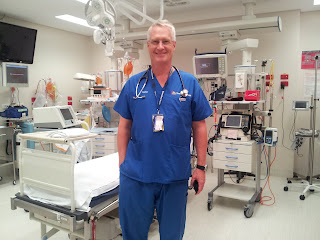 |
| In my element, a modern ED |
Looking over past posts, it seems that I’ve neglected somewhat the whole point of our being here, which is to help deliver high-quality, world-class EM care to the local population. The US is at the forefront of EM training, and as a proud graduate of Boston City Hospital’s EM class of 1994, seven graduates in total, now with some 18 years of experience behind me, I’ve seen a lot; good, bad and atrocious. I’ve gained that most valuable of commodities, perspective. I have to say, Queensland Health has been great to us, delivering on all promises. The ED at Redland Hospital is larger and more progressive than expected. The area is growing rapidly, and as the penultimate service industry, so is the hospital.
 |
| This thing rocks!! The modern stethescope.. |
For all you Medical Systems wonks out there; we have a dedicated Radiology suite, a 64 slice GE CT scanner, with a Fufi Synapse PACS just being implemented. Cool, as it’s the same system I’ve been using in NY for the last eight years. Lab is spotty with I-Stat bedside testing done after hours for basic stuff. Critical labs are still couriered into Brisbane! As in many non-tertiary Hospitals, sub-specialty coverage is spotty, to non-existent, and limited after hours. We have general surgery for elective stuff, but no real after hours emergency surgery. So, less sub-specialty coverage than in the US overall.
 |
| The next generation of life savers? |
Due to a lack of Ortho coverage, and potentially delayed Ortho clinic follow-up, it’s typical for EM docs to do definitive fracture reductions in the ED by means of the ingenious Bier’s Block. This is a historic footnote in US EM training programs; but basically you elevate and blanch the affected limb, apply a double tourniquet above, and inject a lipophilic, short-acting anesthetic agent into the limb, generally Prilocaine. Within 10 minutes or so you get a dense regional anesthesia to said limb, and curiously, you can bend and twist and pull outrageous amounts of traction on a little old lady’s arm to get the reduction, while she sits beside you smiling the whole time… It works well, avoids airway and breathing issues and wears off quickly. Lawsuit city in the US, but a practical adaptation to local realities in most of Australia. One interesting side note is that it’s critical to use a short acting, lipophilic agent, and keep the tourniquets up for a minimum of 25 min. post-procedure. This allows the anesthetic to fully bind and redistribute into the fat and be neutralized. There are case reports of brief procedures and early deflation causing a massive rush of anesthetic back into the patient’s central circulation; end result being a cardiac arrest, aka “lawsuit city.”
 |
| A Bier’s Block, post reduction and splinting |
 |
| No longer a room, an Emergency Department. |
 |
| 20 acute beds, 5 short stay and 6 walk-in. And growing. |
While the quality of care is generally high; as in the US, the healthcare system is straining under almost unlimited demand, lack of capacity and disorganized healthcare delivery and records. Being a primarily government-funded system, though with a surprisingly large component of privately insured patients, and lacking the aggressive cost-containment demands of a US-style private insurance industry, Australia is at least a decade behind the US in terms of implementation of robust electronic medical records (EMR) and charge capture.
 |
| Our future challenge…. |
As in the US, care for the aging, more chronically ill patient population is consuming an ever larger portion of HC spending. When discussing the future of EM care delivery with the junior residents, I stick with Dr. Nolan’s pithy, four word adage, “Older, sicker, poorer, fatter…” That about sums it up people, a neat encapsulation of the challenges ahead.
Wishing you become none of the foregoing, at least not too soon… Best, ddu
 |
| Redland Hospital courtyard |







